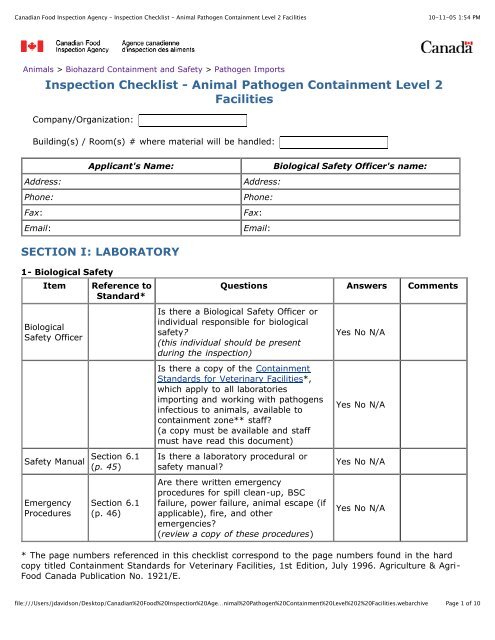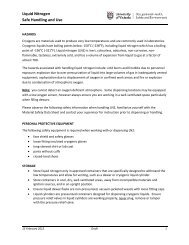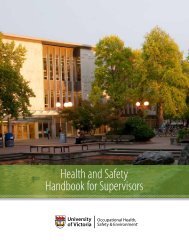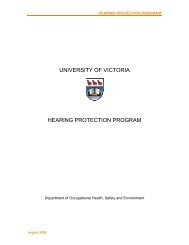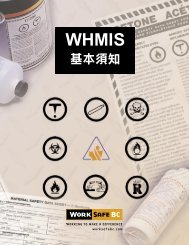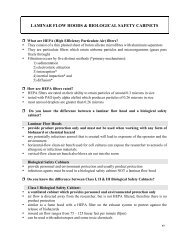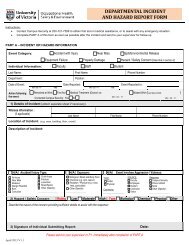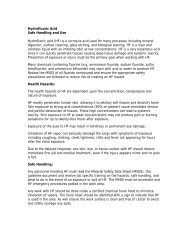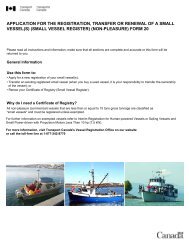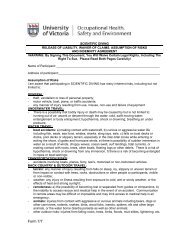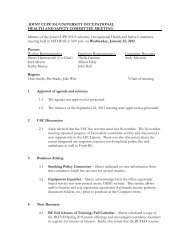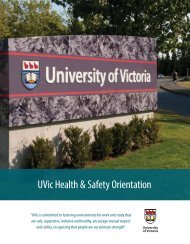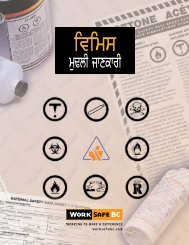Inspection Checklist - Occupational Health and Safety
Inspection Checklist - Occupational Health and Safety
Inspection Checklist - Occupational Health and Safety
You also want an ePaper? Increase the reach of your titles
YUMPU automatically turns print PDFs into web optimized ePapers that Google loves.
Canadian Food <strong>Inspection</strong> Agency - <strong>Inspection</strong> <strong>Checklist</strong> - Animal Pathogen Containment Level 2 Facilities<br />
10-11-05 1:54 PM<br />
Animals > Biohazard Containment <strong>and</strong> <strong>Safety</strong> > Pathogen Imports<br />
<strong>Inspection</strong> <strong>Checklist</strong> - Animal Pathogen Containment Level 2<br />
Facilities<br />
Company/Organization:<br />
Building(s) / Room(s) # where material will be h<strong>and</strong>led:<br />
Address:<br />
Phone:<br />
Fax:<br />
Email:<br />
Applicant's Name:<br />
Biological <strong>Safety</strong> Officer's name:<br />
Address:<br />
Phone:<br />
Fax:<br />
Email:<br />
SECTION I: LABORATORY<br />
1- Biological <strong>Safety</strong><br />
Item<br />
Biological<br />
<strong>Safety</strong> Officer<br />
<strong>Safety</strong> Manual<br />
Emergency<br />
Procedures<br />
Reference to<br />
St<strong>and</strong>ard*<br />
Section 6.1<br />
(p. 45)<br />
Section 6.1<br />
(p. 46)<br />
Questions Answers Comments<br />
Is there a Biological <strong>Safety</strong> Officer or<br />
individual responsible for biological<br />
safety?<br />
(this individual should be present<br />
during the inspection)<br />
Is there a copy of the Containment<br />
St<strong>and</strong>ards for Veterinary Facilities*,<br />
which apply to all laboratories<br />
importing <strong>and</strong> working with pathogens<br />
infectious to animals, available to<br />
containment zone** staff?<br />
(a copy must be available <strong>and</strong> staff<br />
must have read this document)<br />
Is there a laboratory procedural or<br />
safety manual?<br />
Are there written emergency<br />
procedures for spill clean-up, BSC<br />
failure, power failure, animal escape (if<br />
applicable), fire, <strong>and</strong> other<br />
emergencies?<br />
(review a copy of these procedures)<br />
Yes No N/A<br />
Yes No N/A<br />
Yes No N/A<br />
Yes No N/A<br />
* The page numbers referenced in this checklist correspond to the page numbers found in the hard<br />
copy titled Containment St<strong>and</strong>ards for Veterinary Facilities, 1st Edition, July 1996. Agriculture & Agri-<br />
Food Canada Publication No. 1921/E.<br />
file:///Users/jdavidson/Desktop/Canadian%20Food%20<strong>Inspection</strong>%20Age…nimal%20Pathogen%20Containment%20Level%202%20Facilities.webarchive<br />
Page 1 of 10
Canadian Food <strong>Inspection</strong> Agency - <strong>Inspection</strong> <strong>Checklist</strong> - Animal Pathogen Containment Level 2 Facilities<br />
10-11-05 1:54 PM<br />
** In this section, the expression "Containment zone" is used merely to simplify the text; it refers to<br />
laboratory room(s) <strong>and</strong>/or animal facility(ies) where the animal pathogen will be used.<br />
2 - Training<br />
Item<br />
Training<br />
Reference to<br />
St<strong>and</strong>ard<br />
Section 6.1<br />
(p. 45)<br />
Section 6.1<br />
(p. 45)<br />
Section 6.1<br />
(p. 45)<br />
Section 6.1<br />
(p. 45)<br />
Questions Answers Comments<br />
Have containment zone staff read <strong>and</strong><br />
understood the safety manual?<br />
(ask a staff member if they read the<br />
manual)<br />
Do all persons in the containment zone<br />
know <strong>and</strong> follow the operational<br />
protocols for the projects in process?<br />
Does employee training include the<br />
review of Material <strong>Safety</strong> Data Sheets<br />
(MSDS)*** for the pathogens h<strong>and</strong>led<br />
in the laboratory?<br />
(verify if they are available <strong>and</strong> used<br />
during training. If not publicly available,<br />
the applicant or trainer must prepare<br />
their own MSDS)<br />
Is there written documentation of the<br />
training provided?<br />
(review this documentation, it must<br />
describe the training provided <strong>and</strong> has<br />
to be signed by the both the employee<br />
<strong>and</strong> the supervisor)<br />
Are the employees (i.e. researchers<br />
<strong>and</strong>/or technicians) working in the<br />
containment zone responsible for<br />
housekeeping?<br />
Are non-laboratory staff (i.e. janitors,<br />
maintenance workers, contractors,<br />
visitors) entering the containment zone<br />
trained in the hazards associated with<br />
the imported material?<br />
(review the training given / visitor's<br />
policy)<br />
Yes No N/A<br />
Yes No N/A<br />
Yes No N/A<br />
Yes No N/A<br />
Yes No N/A<br />
Yes No N/A<br />
*** Several MSDS can be found on the CFIA or PHAC website, at<br />
http://www.inspection.gc.ca/english/sci/bio/anima/disemala/disemalae.shtml <strong>and</strong> http://www.phacaspc.gc.ca/msds-ftss/index-eng.php<br />
respectively.<br />
3 - Physical Requirements<br />
Access<br />
Item<br />
Reference to<br />
St<strong>and</strong>ard<br />
Sections 3.1,<br />
3.2 <strong>and</strong> 3.3<br />
(p. 6, 17, 26)<br />
Questions Answers Comments<br />
Is access to the laboratory area<br />
restricted to persons on official<br />
business?<br />
Yes No N/A<br />
file:///Users/jdavidson/Desktop/Canadian%20Food%20<strong>Inspection</strong>%20Age…nimal%20Pathogen%20Containment%20Level%202%20Facilities.webarchive<br />
Page 2 of 10
Canadian Food <strong>Inspection</strong> Agency - <strong>Inspection</strong> <strong>Checklist</strong> - Animal Pathogen Containment Level 2 Facilities<br />
10-11-05 1:54 PM<br />
Signs<br />
Offices<br />
Surface<br />
Finishes<br />
General<br />
Condition<br />
Perimeter<br />
Air H<strong>and</strong>ling<br />
System<br />
Biological<br />
<strong>Safety</strong><br />
Cabinets<br />
(BSC)<br />
(p. 6, 17, 26)<br />
Sections 3.1,<br />
3.2 <strong>and</strong> 3.3<br />
(p. 6, 17, 26)<br />
Sections 3.1,<br />
3.2 <strong>and</strong> 3.3<br />
(p. 6, 17, 26)<br />
Sections 3.1,<br />
3.2 <strong>and</strong> 3.3<br />
(p. 6, 17, 26)<br />
Sections 3.1,<br />
3.2, 3.3 <strong>and</strong><br />
6.2<br />
(p. 7, 16, 26,<br />
<strong>and</strong> 47)<br />
Section 3.1<br />
(p. 8)<br />
Section 3.5<br />
(p. 37)<br />
Section 6.2<br />
(p. 47)<br />
Sections 3.1,<br />
3.2 <strong>and</strong> 3.3<br />
(p. 8, 19, 30)<br />
Sections 3.1,<br />
3.2 <strong>and</strong> 3.3<br />
(p. 10, 20,<br />
31)<br />
Sections 3.1<br />
<strong>and</strong> 5.2<br />
(p. 10, 43)<br />
Sections 5.0<br />
<strong>and</strong> 6.2<br />
(p. 41, 48)<br />
(determine how - locks <strong>and</strong>/or signs)<br />
Are biohazard signs posted on the<br />
containment zone doors warning of the<br />
agents in use; <strong>and</strong> entry requirements,<br />
if applicable?<br />
Do the signs list the name <strong>and</strong> phone<br />
number of the person to contact in<br />
case of emergency?<br />
Are office areas located outside of<br />
working areas?<br />
(paperwork stations are permitted<br />
within the areas)<br />
Are the paperwork stations (<strong>and</strong><br />
reference material area) in the<br />
containment zone located away from<br />
hazardous materials?<br />
Yes No N/A<br />
Yes No N/A<br />
Yes No N/A<br />
Yes No N/A<br />
Are the floors slip-resistant? Yes No N/A<br />
Are surfaces in the rooms scratch,<br />
stain, moisture, chemical <strong>and</strong> heat<br />
resistant; in accordance with function?<br />
(they should be in good condition,<br />
cleanable <strong>and</strong> resistant to disinfection)<br />
Are the rooms kept neat, orderly <strong>and</strong><br />
clean?<br />
Are doors <strong>and</strong> windows to the<br />
containment zone kept closed?<br />
(check to make sure there they are all<br />
closed, doorstop shouldn't be present)<br />
Does the containment zone have<br />
inward directional airflow?<br />
(check this at doorway using a smoke<br />
pencil or tissue)<br />
Does the HVAC system (heating,<br />
ventilation, air conditioning) interfere<br />
with the airflows of biological safety<br />
cabinets?<br />
(check to make sure cabinets are not<br />
located directly under a supply diffuser)<br />
Are BSCs used for aerosol generating<br />
procedures <strong>and</strong> with high concentration<br />
or large volumes of infectious<br />
materials?<br />
(work with level 2 agents on the bench<br />
is permitted - supervisor must assess<br />
which procedures to be done in BSC)<br />
Yes No N/A<br />
Yes No N/A<br />
Yes No N/A<br />
Yes No N/A<br />
Yes No N/A<br />
Yes No N/A<br />
file:///Users/jdavidson/Desktop/Canadian%20Food%20<strong>Inspection</strong>%20Age…nimal%20Pathogen%20Containment%20Level%202%20Facilities.webarchive<br />
Page 3 of 10
Canadian Food <strong>Inspection</strong> Agency - <strong>Inspection</strong> <strong>Checklist</strong> - Animal Pathogen Containment Level 2 Facilities<br />
10-11-05 1:54 PM<br />
Section 5.0<br />
(p. 41)<br />
Section 5.2<br />
(p. 44)<br />
Are employees using BSCs trained in<br />
their correct use <strong>and</strong> care <strong>and</strong> have a<br />
good underst<strong>and</strong>ing of their operation?<br />
(verify training records <strong>and</strong> ask a staff<br />
member to describe the procedure)<br />
Are BSCs certified in accordance with<br />
NSF/ANSI 49 Class II (LaminarFlow)<br />
Biohazard Cabinetry at least annually?<br />
(check for certification sticker - some<br />
BSCs needs to be certified according to<br />
manufacturer specifications)<br />
Yes No N/A<br />
Yes No N/A<br />
Laboratory<br />
Services<br />
Pest Program<br />
Section 5.2<br />
(p. 44)<br />
Section 5.2<br />
(p. 44)<br />
Section 3.1<br />
(p. 12)<br />
4 - Decontamination<br />
Item<br />
Decontamination<br />
Sections 3.1,<br />
3.2 <strong>and</strong> 3.3<br />
(p. 14, 24,<br />
34)<br />
Sections 3.1,<br />
3.2 <strong>and</strong> 3.3<br />
(p. 22, 33,<br />
38)<br />
Sections 3.1,<br />
3.2, 3.3 <strong>and</strong><br />
6.1<br />
(p. 9, 20, 30,<br />
<strong>and</strong> 46)<br />
Reference to<br />
St<strong>and</strong>ard<br />
Section 6.2<br />
(p. 48)<br />
Does the certification sticker indicate<br />
the date of next certification, to what<br />
st<strong>and</strong>ards the tests were performed<br />
<strong>and</strong> the name of the certifier?<br />
Is a copy of the certification report<br />
readily available?<br />
(ask to see a copy of the report)<br />
Are emergency eyewash facilities <strong>and</strong><br />
emergency shower equipment provided<br />
in the containment zone?<br />
(in accordance with activities performed<br />
<strong>and</strong> applicable regulations i.e. ANSI<br />
Z358.1 St<strong>and</strong>ard)<br />
Are life-safety systems, lighting, <strong>and</strong><br />
essential equipment supported by<br />
normal emergency power?<br />
Are h<strong>and</strong> washing sinks provided in the<br />
containment zone?<br />
(check to see if the sinks are of h<strong>and</strong>sfree<br />
operation, should be dedicated to<br />
this use only)<br />
Is the facility proofed against vermin<br />
<strong>and</strong> insects?<br />
(do they have a exterminator contract;<br />
check for dead flies <strong>and</strong> mouse<br />
droppings)<br />
Yes No N/A<br />
Yes No N/A<br />
Yes No N/A<br />
Yes No N/A<br />
Yes No N/A<br />
Yes No N/A<br />
Questions Answers Comments<br />
Are all contaminated materials<br />
decontaminated before disposal,<br />
reuse or removal from the<br />
containment zone?<br />
(includes solid & liquid wastes,<br />
contaminated clothing, gloves,<br />
equipments, etc.)<br />
Yes No N/A<br />
file:///Users/jdavidson/Desktop/Canadian%20Food%20<strong>Inspection</strong>%20Age…nimal%20Pathogen%20Containment%20Level%202%20Facilities.webarchive<br />
Page 4 of 10
Canadian Food <strong>Inspection</strong> Agency - <strong>Inspection</strong> <strong>Checklist</strong> - Animal Pathogen Containment Level 2 Facilities<br />
10-11-05 1:54 PM<br />
Sections 3.1,<br />
3.2 <strong>and</strong> 3.3<br />
(p. 9, 19, 30)<br />
Is there an appropriate method for<br />
decontamination provided in the<br />
facility (e.g. incinerator, autoclave)?<br />
(determine how contaminated items<br />
are treated - can be processed in a<br />
central decontamination area outside<br />
of facility if properly contained <strong>and</strong><br />
transported.)<br />
Yes No N/A<br />
Please<br />
specify which<br />
method(s)<br />
used<br />
If the facility does not have access<br />
to an autoclave or other effective<br />
means of decontamination, are<br />
biohazardous wastes picked up for<br />
disposal by a specialized company?<br />
Yes No N/A<br />
Please name<br />
the company<br />
(if applicable)<br />
Section 6.5<br />
(p. 60)<br />
Are written procedures available for<br />
the decontamination methods used?<br />
(ask to review a copy of these<br />
documents)<br />
Yes No N/A<br />
Autoclaves<br />
Section 3.1<br />
(p. 9)<br />
Is the autoclave located in the<br />
laboratory zone?<br />
(can be located in a central<br />
decontamination area for the facility)<br />
Yes No N/A<br />
Section 3.1<br />
(p. 9)<br />
Is the autoclave equipped with a<br />
cycle log recorder?<br />
(examine one of the print outs of a<br />
run <strong>and</strong> check for sterilization, i.e.<br />
121°C)<br />
Yes No N/A<br />
Sections 6.2<br />
<strong>and</strong> 6.5<br />
(p. 48, 61)<br />
Are the autoclave cycle log<br />
recordings kept on file?<br />
(review these files)<br />
Yes No N/A<br />
Sections 6.2<br />
<strong>and</strong> 6.5<br />
(p. 48, 61)<br />
Is the efficacy of the autoclave<br />
monitored using biological indicators?<br />
(ask to see their indicators <strong>and</strong> how<br />
they conduct this testing)<br />
Yes No N/A<br />
Sections 6.2<br />
<strong>and</strong> 6.5<br />
(p. 48, 61)<br />
Are records of the efficacy testing<br />
kept on file?<br />
(review these files)<br />
Yes No N/A<br />
Work surfaces<br />
Section 6.2<br />
(p. 48)<br />
Are contaminated work surfaces<br />
decontaminated at the end of the<br />
day?<br />
(ask to review the procedure; see if<br />
contact time is respected)<br />
Yes No N/A<br />
Section 6.5<br />
(p. 61)<br />
Are the disinfectants used for<br />
decontamination effective against the<br />
imported agent?<br />
(check to see which disinfectants are<br />
available)<br />
Yes No N/A<br />
Please specify<br />
which<br />
disinfectants<br />
<strong>and</strong><br />
concentrations<br />
used<br />
5 - Operational Practices<br />
file:///Users/jdavidson/Desktop/Canadian%20Food%20<strong>Inspection</strong>%20Age…nimal%20Pathogen%20Containment%20Level%202%20Facilities.webarchive<br />
Page 5 of 10
Canadian Food <strong>Inspection</strong> Agency - <strong>Inspection</strong> <strong>Checklist</strong> - Animal Pathogen Containment Level 2 Facilities<br />
10-11-05 1:54 PM<br />
Item<br />
Uniforms<br />
Gloves<br />
H<strong>and</strong>washing<br />
Footwear<br />
Hair<br />
Eating <strong>and</strong><br />
others<br />
Storage<br />
6 - Records<br />
Item<br />
Records<br />
Reference to<br />
St<strong>and</strong>ard<br />
Section 6.2<br />
(p. 47)<br />
Section 6.2<br />
(p. 47)<br />
Section 6.2<br />
(p. 47)<br />
Section 6.2<br />
(p. 48)<br />
Section 6.2<br />
(p. 47)<br />
Section 6.2<br />
(p. 47)<br />
Section 6.2<br />
(p. 47)<br />
Section 6.2<br />
(p. 47)<br />
Section 6.2<br />
(p. 48)<br />
Reference to<br />
St<strong>and</strong>ard<br />
Section 6.2<br />
(p. 47)<br />
Questions Answers Comments<br />
Are uniforms (lab coats, gowns,<br />
coveralls) worn when working in the<br />
containment zone?<br />
Are the lab coats worn only in the<br />
laboratory areas?<br />
(check to see if anyone is wearing lab<br />
coats in offices, cafeteria, library)<br />
Are gloves worn when directly<br />
contacting the imported infectious<br />
materials (or infected animals)?<br />
Are gloves decontaminated before<br />
disposal?<br />
(check to ensure no gloves are<br />
disposed of in regular garbage)<br />
Are h<strong>and</strong>s washed frequently: after<br />
h<strong>and</strong>ling infectious materials, after<br />
removing gloves, <strong>and</strong> before leaving<br />
the containment zone?<br />
(if you've touched anything in the lab,<br />
does staff make you wash your h<strong>and</strong>s<br />
when you leave the area)<br />
Is appropriate footwear worn in the<br />
containment zone?<br />
(employees must wear low-heel, closed<br />
heel <strong>and</strong> closed toe shoes. Preferably,<br />
they should be made of non-absorbent<br />
material)<br />
Is long hair tied back so that it cannot<br />
come into contact with h<strong>and</strong>s,<br />
specimens <strong>and</strong> equipment?<br />
(check employee's hair)<br />
Is eating, chewing gum, smoking,<br />
storing food <strong>and</strong> applying cosmetics<br />
allowed?<br />
(check the fridge for food)<br />
Are infectious agents stored inside the<br />
containment zone?<br />
(infectious agents stored outside the<br />
zone should be kept locked, in<br />
leakproof containers)<br />
Yes No N/A<br />
Yes No N/A<br />
Yes No N/A<br />
Yes No N/A<br />
Yes No N/A<br />
Yes No N/A<br />
Yes No N/A<br />
Yes No N/A<br />
Questions Answers Comments<br />
Are there records kept of the imported<br />
pathogen? Yes No N/A<br />
file:///Users/jdavidson/Desktop/Canadian%20Food%20<strong>Inspection</strong>%20Age…nimal%20Pathogen%20Containment%20Level%202%20Facilities.webarchive<br />
Page 6 of 10
Canadian Food <strong>Inspection</strong> Agency - <strong>Inspection</strong> <strong>Checklist</strong> - Animal Pathogen Containment Level 2 Facilities<br />
10-11-05 1:54 PM<br />
(p. 47)<br />
Section 6.2<br />
(p. 47)<br />
(review these records)<br />
Do the records indicate where the<br />
pathogen was used/stored <strong>and</strong> the date<br />
of disposal?<br />
(trace an imported pathogen through<br />
the record system from receipt to<br />
disposal)<br />
Yes No N/A<br />
SECTION II: IN VIVO WORK<br />
Do you intend to use an animal pathogen for work with animals:<br />
Yes, please complete the following additional questions.<br />
No, please go directly to Section III, page 7.<br />
7 - Animal Facilities - Physical Requirements<br />
Please list the room number(s) which apply to this section (where animals are held):<br />
Item<br />
Animal rooms<br />
Access<br />
Office<br />
Storage<br />
Surface<br />
Finishes<br />
Reference to<br />
St<strong>and</strong>ard<br />
Sections 3.2<br />
<strong>and</strong> 3.3<br />
(p. 17, 26)<br />
Sections 3.2<br />
<strong>and</strong> 3.3<br />
(p. 18, 27)<br />
Section 3.2<br />
(p. 18)<br />
Sections 3.2<br />
<strong>and</strong> 3.3<br />
(p. 16, 25,<br />
26)<br />
Sections 3.2<br />
<strong>and</strong> 3.3<br />
(p. 16, 26)<br />
Sections 3.2<br />
<strong>and</strong> 3.3<br />
(p. 19, 29)<br />
Sections 3.2<br />
<strong>and</strong> 3.3<br />
(p. 18, 19,<br />
29, <strong>and</strong> 30)<br />
Questions Answers Comments<br />
What animals are housed in this animal<br />
facility?<br />
Is the entry <strong>and</strong> exit area for personnel<br />
provided via ventilated airlock?<br />
(ventilation provided through leaky<br />
doors <strong>and</strong>/or HVAC systems)<br />
Is the entry <strong>and</strong> exit area for personnel<br />
provided with a clothing change area?<br />
Is the entry area for animals provided<br />
via ventilated airlock?<br />
(ventilation provided through leaky<br />
doors)<br />
Are office areas located outside of<br />
animal facility working areas?<br />
(paperwork stations must be located<br />
outside of the animal rooms)<br />
Are adequate feed <strong>and</strong> bedding storage<br />
areas provided within the containment<br />
zone?<br />
Are the floors slip-resistant, cleanable,<br />
<strong>and</strong> comprising a slope towards floor<br />
drains?<br />
Are the interior surfaces (coatings)<br />
continuous, impact resistant <strong>and</strong><br />
minimize the movement of gases <strong>and</strong><br />
liquids through the perimeter<br />
membrane, in accordance with<br />
Small animals<br />
Large animals<br />
Aquatic<br />
animals<br />
Yes No N/A<br />
Yes No N/A<br />
Yes No N/A<br />
Yes No N/A<br />
Yes No N/A<br />
Yes No N/A<br />
Yes No N/A<br />
Please list<br />
the different<br />
animal<br />
species used<br />
file:///Users/jdavidson/Desktop/Canadian%20Food%20<strong>Inspection</strong>%20Age…nimal%20Pathogen%20Containment%20Level%202%20Facilities.webarchive<br />
Page 7 of 10
Canadian Food <strong>Inspection</strong> Agency - <strong>Inspection</strong> <strong>Checklist</strong> - Animal Pathogen Containment Level 2 Facilities<br />
10-11-05 1:54 PM<br />
function?<br />
Sections 3.2<br />
<strong>and</strong> 3.3<br />
(p. 19, 30)<br />
Are doors <strong>and</strong> frames of animal rooms<br />
of non-absorptive material, have solid<br />
finishes, or sealed?<br />
(wood is not acceptable)<br />
Yes No N/A<br />
Small animals<br />
- General<br />
Section 3.2<br />
(p. 16)<br />
Is a clean <strong>and</strong> dirty cage washing area<br />
provided in the containment zone?<br />
(if not, determine how cages are<br />
cleaned)<br />
Yes No N/A<br />
Small Animals<br />
- Primary<br />
Containment<br />
Devices<br />
Section 6.3<br />
(p. 53)<br />
Are containment caging systems used?<br />
(this is optional at level 2 but some<br />
facilities may use them)<br />
Yes No N/A<br />
Experimental<br />
Areas / Post<br />
Mortem Room<br />
Sections 3.2<br />
<strong>and</strong> 3.3<br />
(p. 16, 26)<br />
Are experimental areas (i.e. for<br />
necropsy, surgical procedures) provided<br />
<strong>and</strong> separated from animal rooms?<br />
(for large animal facility, a Post Mortem<br />
room should be available)<br />
Yes No N/A<br />
Laboratory<br />
Services<br />
Sections 3.2<br />
<strong>and</strong> 3.3<br />
(p. 22, 33)<br />
Are h<strong>and</strong>s-free h<strong>and</strong> washing sinks<br />
provided in the animal facility?<br />
Yes No N/A<br />
8 - Animal Facilities - Operational Practices<br />
Item<br />
Uniforms<br />
Reference to<br />
St<strong>and</strong>ard<br />
Section 6.3<br />
(p. 52)<br />
Section 6.3<br />
(p. 53)<br />
Section 6.3<br />
(p. 52)<br />
Questions Answers Comments<br />
Are coveralls <strong>and</strong> dedicated footwear<br />
worn when working in the animal<br />
facility?<br />
(or other equivalent clothing)<br />
Are appropriate methods for protective<br />
clothing in place for work in each<br />
animal room?<br />
(i.e. do they use disinfectant footbaths<br />
or change clothing between animal<br />
rooms?)<br />
Are respirators worn when h<strong>and</strong>ling<br />
potentially zoonotic agents than cannot<br />
be contained in primary containment<br />
devices?<br />
SECTION III: ANIMAL PATHOGENS USED<br />
Please check the product(s) h<strong>and</strong>led in your laboratory:<br />
Yes No N/A<br />
Yes No N/A<br />
Yes No N/A<br />
bacteria<br />
viruses<br />
cell lines<br />
toxins<br />
file:///Users/jdavidson/Desktop/Canadian%20Food%20<strong>Inspection</strong>%20Age…nimal%20Pathogen%20Containment%20Level%202%20Facilities.webarchive<br />
Page 8 of 10
Canadian Food <strong>Inspection</strong> Agency - <strong>Inspection</strong> <strong>Checklist</strong> - Animal Pathogen Containment Level 2 Facilities<br />
10-11-05 1:54 PM<br />
fungi<br />
recombinant organisms<br />
infected animal products<br />
other<br />
Please list the organisms or biological material routinely used:<br />
SECTION IV: DECLARATION<br />
I hereby declare that the information given above is complete, true, <strong>and</strong> accurate to the best of<br />
my knowledge <strong>and</strong> belief.<br />
I agree to abide by the requirements outlined in the Containment St<strong>and</strong>ards for Veterinary Facilities<br />
as well as any additional guidelines or conditions provided to me by the Office of Biohazard<br />
Containment <strong>and</strong> <strong>Safety</strong>, CFIA.<br />
I underst<strong>and</strong> that failure to comply with the above may result in sanctions <strong>and</strong> possible seizure of<br />
material regulated under the <strong>Health</strong> of Animal Acts <strong>and</strong> its Regulations.<br />
Signature of Applicant:<br />
Signature of Biological <strong>Safety</strong> Officer:<br />
Position or Title:<br />
Position or Title:<br />
Date:<br />
Date:<br />
Internal Use Only<br />
Comments:<br />
Added to the database:<br />
Compliance letter sent to #c-:<br />
Reviewed by:<br />
Date:<br />
ONCE COMPLETED, PLEASE FORWARD (EMAIL, FAX, OR MAIL) TO:<br />
Canadian Food <strong>Inspection</strong> Agency<br />
Office of Biohazard Containment <strong>and</strong> <strong>Safety</strong><br />
Animal Pathogen Importation Program<br />
1400 Merivale Road, Ottawa ON K1A 0Y9<br />
file:///Users/jdavidson/Desktop/Canadian%20Food%20<strong>Inspection</strong>%20Age…nimal%20Pathogen%20Containment%20Level%202%20Facilities.webarchive<br />
Page 9 of 10
Canadian Food <strong>Inspection</strong> Agency - <strong>Inspection</strong> <strong>Checklist</strong> - Animal Pathogen Containment Level 2 Facilities<br />
10-11-05 1:54 PM<br />
Phone: 613-773-6520<br />
Facsimile: 613-773-6521<br />
Email: importzoopath@inspection.gc.ca<br />
Date modified: 2010-02-26Date<br />
modified: 2010-02-26<br />
file:///Users/jdavidson/Desktop/Canadian%20Food%20<strong>Inspection</strong>%20Age…imal%20Pathogen%20Containment%20Level%202%20Facilities.webarchive<br />
Page 10 of 10


